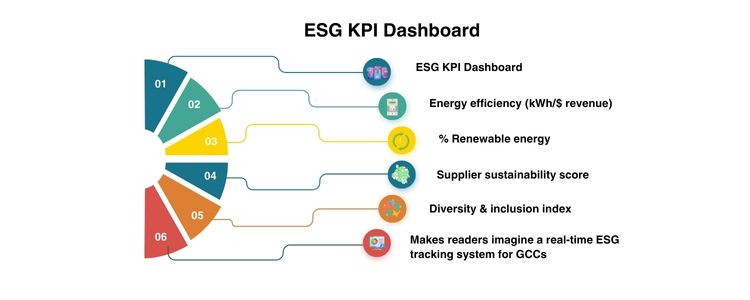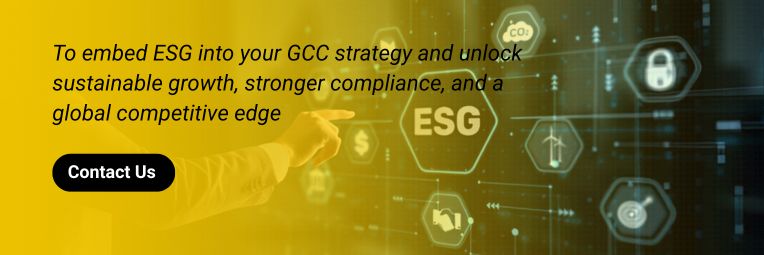
It’s a scene playing out in boardrooms across Bengaluru. The quarterly review was in full swing, and the usual metrics like utilisation rates, time-to-market, and cost efficiency, were on the screen. But then, a new chart appears: carbon footprint per project delivered. This isn’t just a sidebar; it’s a clear signal that sustainability has moved from a corporate social responsibility (CSR) talking point to a core business expansion strategy.
For years, Global Capability Centres (GCCs) have focused on operational and financial metrics. The goal was simple: deliver faster, cheaper, and at higher capacity. The environmental and social impact of these targets was rarely a factor. However, nothing is the same anymore. The most innovative GCCs are currently adopting a more progressive set of metrics which covers the environmental, social and governance factors (ESG). Here is how traditional KPIs are becoming ESG-integrated ones:
This shift isn’t happening in a vacuum. A perfect storm of client demands, regulatory changes, and investor pressure is making ESG a competitive necessity.
To integrate ESG, the following four-step journey has been proving successful to GCCs:
Beyond the traditional financial metrics, these are the new numbers driving success:
It is not only a conceptual change but also a practical change to ESG that is currently taking place:
It is estimated that India’s GCC sector will realise more than $100 billion in revenue and 2.8 million direct jobs by 2030, with a potential of 2 per cent of Indian GDP. Among the GCCs that will show this growth are the ones that embed ESG into their core strategy. They will be in better positions to pursue high-valued international contracts, access to high-calibre human resources, as well as favourable funding.
We foresee that AI-enabled ESG dashboards will become commonplace to track both market expansion strategy compliance and performance in real time. The cities with increased renewable energy capability can also become the citadels of ESG-preferred GCC clusters, further establishing India as the destination of next-generation captive centers. ESG is no longer merely a compliance box. It is the latest currency of the competitive advantage. Leaders of the future will not only provide results but will provide them with a clear conscience, a carbon label and a diversity badge.
A GDC refers to a single-minded offshore deployment, which provides proficient business, technology and operational services to corporate bodies on a global basis. BFSI, IT services, healthcare, telecom, retail, manufacturing, and other upcoming technologies, including AI and blockchain. They do not only target cost savings but now aim at innovation, automation, R&D, digital transformation, and high-value consulting. They design and create cloud, artificial intelligence, analytics, cloud security, and process automation. A large supply of STEM graduates, multilingual workers and niche skills in AI, ML, cloud, and analytics. Aditi, with a strong background in forensic science and biotechnology, brings an innovative scientific perspective to her work. Her expertise spans research, analytics, and strategic advisory in consulting and GCC environments. She has published numerous research papers and articles. A versatile writer in both technical and creative domains, Aditi excels at translating complex subjects into compelling insights. Which she aligns seamlessly with consulting, advisory domain, and GCC operations. Her ability to bridge science, business, and storytelling positions her as a strategic thinker who can drive data-informed decision-making.
From Old KPIs to a New World of ESG
Why ESG Is Now Business-Critical for GCCs

A New And Updated Playbook On GCC Leaders
The Numbers Game: Metrics That Matter Now
Metric
What It Measures
Why It’s Strategic
Energy Efficiency Ratio
Kilowatt-hours per dollar of revenue
Reduces operational costs and emissions, a key factor in global tenders.
Emissions Intensity
CO₂e per FTE
Enhances brand positioning and helps win contracts with sustainability-focused clients.
Water Usage per Project Cycle
Litres per project
Helps meet climate resilience targets and manage a critical resource.
Diversity Impact Index
Leadership mix by gender and background
Improves talent retention, fosters innovation, and strengthens brand reputation.
Circularity Rate
Percentage of assets reused/recycled
Lowers waste, reduces procurement costs, and supports a circular economy.
Real-World Wins
What Next: ESG as the Competitive Edge
frequently asked questions (FAQs)

Aditi
Hey, like this? Why not share it with a buddy?
Related Posts
Recent Blog / Post
- Agile Methodologies for GCCs: A Blueprint for Success October 6, 2025
- The Legal and Compliance Checklist for a New GCC Setup October 4, 2025
- The Rise of Niche GCCs: A Focus on Specialised Capabilities October 4, 2025
- The Impact of Regulatory Changes on GCC Operations October 4, 2025
- Cybersecurity for GCCs: A Proactive Approach to Data Protection September 30, 2025
- Beyond Cost: Measuring the True ROI of Your GCC Investment September 29, 2025
- The Future of GCCs in the Retail Sector: A Strategic Playbook September 29, 2025
- David vs Goliath: Mid-Sized GCCs Quietly Outperform the Big Brands September 29, 2025
- Infineon’s Big Bet on India: Inside Its First GCC in GIFT City September 29, 2025
- From Campuses to Capability Centres: How Indian Universities Power the Global GCC Ecosystem September 29, 2025
- Retail Meets Digital: Costco’s GCC in Hyderabad Marks a Global Shift September 29, 2025
- The Silent Crisis: Why Many GCCs Plateau After 3 Years and How to Avoid It September 24, 2025
- Germany’s New Skilled Immigration Act and Its Ripple Effect on the GCC Talent Model September 24, 2025
- From Tokyo to Hyderabad: The Future of GCCs for Japanese Conglomerates September 23, 2025
- GCCs as AI Acceleration Hubs: Collaborating with US and Nordic Tech Majors September 19, 2025
















